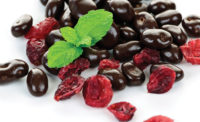With all of the healthy hoopla infiltrating the confectionery world, it’s important to remember that there will always be a demand for indulgent confections.
At least that’s what Courtney LeDrew, marketing manager at Cargill Cocoa and Chocolate, says. “After all, taste is still the number one factor impacting food choices.”
Perhaps the idea that premium bars and confections are an affordable luxury for treating oneself is true. However, health is still important. “Functional foods with inherent benefits have been growing and this trend is expected to continue,” LeDrew says.
She’s not alone. In fact, it seems as though the entire world of confectionery additives has at least one foot in the “better for you” doorway. Different ingredient makers are taking on the trend from all angles.
The end goal of each — to offer healthier additives that will make for more beneficial final products. But it’s not so much about throwing taste out the door as it is offering a delightful indulgence that simultaneously has a positive impact on consumer health.
Sweet for teeth
“Typically we see healthier confections popular with adults, but adolescents are next in line because of schools limiting or eliminating unhealthy type snacks,” says Ed McIntosh, marketing manager at Flavorchem. There’s that, along with the heightened awareness parents have toward healthier options outside of school walls.
The child-specific food and beverage market is expected to grow quickly over the next few years. And, while children play a role in purchase decisions, parents want nutritious, delicious foods that contribute to their child’s health throughout the day. As concerns in these areas intensify, parents are actively seeking foods for meals and snacks that can satisfy hunger while improving the nutrient density of their child’s overall diet.
One of the most immediate worries connected to confections has long been negative dental effects. Parents and dentists alike have always warned that candy equals cavities, especially gum, which can be chomped on for hours, giving it plenty of time to leave sugar in the teeth.
But that could be coming to an end thanks to a new additive launched by BENEO Inc. — Palatinose.
The next generation carbohydrate is being called a new avenue in tooth-friendly confectionery. “It’s the only tooth-friendly carbohydrate derived from sugar beet to be fully digestible and low glycemic,” says Joseph O’Neill, president and general manager at BENEO, Inc.
With a mild sweetness, its sensory profile is very similar to sugar, without any aftertaste. It is processed like sucrose and allows for the development of healthier confectionery products such as the first polyol-free, tooth-friendly bubble gum with a sugar-like taste and sweetness. The nutritional and technological benefits of Palatinose also make it suitable for other tooth-friendly confectionery products, such as chocolate and chocolate lentils or chewy candies.
And additive architects at DuPont also are working a healthier sweetener that’s better for your teeth as well — xylitol. Often used in gums and mints, it inhibits bacteria that causes cavities and plaque.
Cathy Dorko, product manager at DuPont Nutrition and Health, says there’s no doubt tooth health is a big trend when it comes to healthy additives. In fact, it’s becoming more common for customers to state that their products are FDA approved on the label, or that they contain xylitol, or that they inhibit tooth bacteria, etc.
“I’ve been keeping an eye on those products and there’s a number of gum products like Orbit for Kids, which have that claim, along with several other brands,” she says.
Although xylitol has a long history and is by no means new, it’s becoming more popular because of its health benefits, she says.
Protein and functionality
Tooth health isn’t the only trending topic in the world of beneficial confectionery additives though.
Protein is gaining interest and it is at the convergence of a number of trends including: healthy snacking, weight management, sport nutrition, and producing food targeted toward aging adults in the United States.
Evidence indicates that protein is a long-term trend, and not a fad, LeDrew says.
Protein is not just about trying to build muscle, it’s also about weight control, satiety, healthier snacking and sport nutrition, she explains. “Protein products have now become applicable to a wide audience, from aging Baby Boomers and individuals trying to maintain or lose weight, to athletes and anyone seeking products that keep them fuller longer.”
Chocolate and protein pair well together, and Cargill’s Wilbur protein coatings and inclusions offer versatile product solutions for bakers and snack manufacturers.
Under the Wilbur brand, four innovative protein coatings and drops have been launched including Wilbur Y854 confectionery protein wafer, Wilbur Y855 milk confectionery protein wafers, Wilbur Y938 white chocolate protein drops, and Wilbur Y985 cocoa confectionery protein drops.
The cocoa confectionery protein wafers and milk confectionery protein wafers are formulated with 20 percent total protein. Meanwhile, the white chocolate protein drops are formulated with 10 percent total protein and meet the standard of identity for white chocolate.
“These drops have a great white chocolate flavor and a strong visual appeal,” LeDrew says. The cocoa confectionery protein drops are made with 25 percent total protein.
Wilburprotein coatings and inclusions can be used to enrobe, drizzle or bottom nutrition or snack bars. They can also be added to cookies, muffins, breads, snack mixes or any other bakery application where increased protein levels are desired.
For someone who wants a crispy center, Dorko says DuPont has new protein additives, too. Theirs come in the form of nuggets. The cocoa and non-cocoa flavor nuggets are said to range from 60 to 90 percent protein depending on the product.
Cutting calories
And as if DuPont wasn’t busy tending to teeth and protein, they have something to offer the calorie conscious confectionery consumers as well.
“I think sugar and calorie reduction is important in this part of the world,” says Dorko.
One of the ingredients she manages, polydextrose, was originally developed as a bulking agent and introduced to the market back in the 80s. “But since that time we found it has a number of better features that are interesting to a number of customers,” she says.
Dorko says one of its biggest benefits is the fact that it has just one calorie per gram compared to most carbohydrates and proteins, which tend to have around four calories per gram.
“So if somebody wants to reduce sugar or fat or both, they can get a significant reduction in sugar, fat, as well as calories,” she explains.
The additive can be used in most confections, but because it is not very sweet, it can be used in savory products as well.
BENEO is counting calories too, with Isomalt.
The bulk sweetener is derived from pure sugar beet, thus having the same sweetness profile as sugar as well as a sugar-like taste, according to O’Neill.
The sweetening power is about 50 percent of sugar. Being only partially digested, Isomalt provides half as many calories as sucrose and is characterized by having hardly any effect on the blood sugar level. Moreover, the sugar replacer does not produce any tooth-damaging acids during consumption because of its stable molecular structure. It therefore allows for the production of calorie-reduced, low glycemic and tooth-friendly products like hard-boiled candy, chewing gum or even chocolate.
Talk about a wholehearted healthy additive!
It seems that as the need for more beneficial ingredients increases, the definition of “healthy” expands to include practices and products that weren’t always thought to count as healthy.
From those who plant the seed, to those who digest the finished confection, additive architects are being forced to think about how healthy the processing is for everyone involved.
As it turns out, the confectionery additive industry has a lot of influence on, not only food business-wise, but the world socially.
So here’s to healthy, from seed-planter to shopper.











